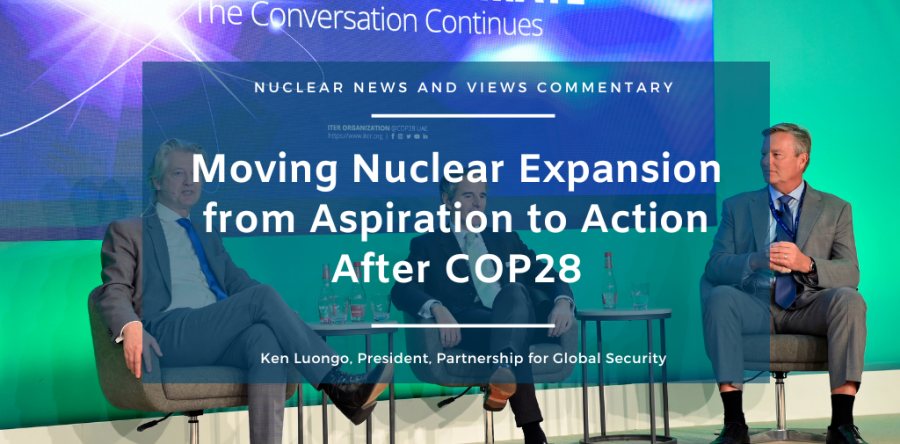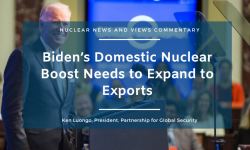The yearly U.N. climate agreement conference of the parties long ago devolved into a cacophonous circus. But this year in Dubai, it at least added a dedicated ring for the clean energy attributes of nuclear power. The IAEA’s Atoms 4 Climate pavilion alone hosted over 40 events.
The issue now is whether the “aspirational goal” of tripling nuclear energy by 2050 as a climate solution can become a reality without allowing Russia and China to remain as the ringmasters.
The threefold nuclear power expansion commitment was endorsed by 24 countries. Another 120 nuclear companies and NGOs endorsed the Net Zero Nuclear Industry Pledge. But there was no representation from Russia or China in either agreement.
Russia is currently the world’s largest nuclear reactor exporter, and China has the most ambitious plans for nuclear power expansion. China just started operation of a gas-cooled next-generation reactor, beating by years the plans of the U.S. and its allies for deployment of similar small nuclear units.
The U.S. and its colleague nations agreed to Jump Start SMR deployments around the world by sharpening the U.S. Export-Import Bank’s financial tools, and they will work to mobilize “at least $4.2 billion in government-led investments” to juice the ability of democratic countries to produce nuclear fuel and wean themselves from dependence on Russia.
But what was missing from any of the COP announcements was a clear roadmap for how to achieve the goals.
Several analyses offered in conjunction with the COP outlined the pieces of the strategy that the U.S. government and its corporate and governmental allies need to develop.
The Breakthrough Institute offered a wake-up call about next-gen nuclear’s prospects based on three failures - the demise of the NuScale-UAMPS deal, the end of X-Energy’s plan to go public, and the NRC’s rejection of OKLO’s initial license application.
It noted that next-gen nuclear advocates are whistling “past the graveyard” and downplaying the “seriousness of the challenges that the technology presently faces and what it will take to overcome them.”
BTI identified five challenges to the commercial expansion of small reactors.
Chief among these is the need to evolve the regulatory regime to reflect the differences between advanced and conventional reactors. Regulatory changes have been made and proposed, but the review process is largely considered as an expensive and overly prescriptive gantlet that punishes reactor developer innovation.
Two other BTI concerns are financial. High interest rates and commodity prices are driving up construction costs and by extension the price of the reactor’s power. A related concern is project costs versus system costs and the penalties associated with the unique nature of nuclear power.
Here, the U.S. government has become a cost-share partner in a number of new nuclear projects to offset the start-up costs. But it has not committed to underwrite the entire nuclear enterprise the way Russia or China do. It is encouraging World Bank loans for nuclear power and sharpening the role of EX-IM. But it does not have a “package deal” with government guarantees that can outcompete Russia or China in new nations considering nuclear units.
The other BTI issues are supply chain bottlenecks and the lack of fuel production capability. The nuclear supply chain atrophy in America is well documented and it will be difficult to reverse. But the government is making strides to produce fuel for next-gen reactors, with Centrus having just completed a run of kilogram quantity HALEU and the COP announcement on future fuel development with its allies. An adequate supply of HALEU is a critical issue for next-gen success.
A collaboration between the EFI Foundation, Clean Air Task Force, and Nuclear Threat Initiative, resulted in a six dimension playbook to support nuclear energy development in new nations.
Like BTI, it touched on regulatory, financial, and project execution issues, noting that using regulatory best practices, creating a welcoming nuclear investment climate, and effectively managing projects are important foundations for success.
But it also covered the challenges posed by workforce development, nonproliferation and security, and the management of spent fuel. The workforce issue is vexing for many countries, aside from Russia and China, because nuclear construction had slowed to a crawl in previous decades.
The nonproliferation and spent fuel recommendations were for nations new to nuclear power to initially use a once-through fuel cycle based on a light-water reactor design.
The challenge with this approach, however, is that it may be difficult to identify reactors with a power output many embarking nations can absorb. Most LWRs are GW-sized. The NuScale VOYGR is one example of a light water-cooled SMR that is much smaller.
But the U.S. and its allies are pouring billions of dollars into the development of advanced reactors that are not light-water cooled and that are sized for developing economy nations or industrial processes. To ultimately be successful, whichever of these reactors rise to the top will need to have an export market as well as domestic applications, like replacing coal plants.
As PGS has continually noted, the identification, characterization, and preparation of these export markets is essential and why a detailed roadmap would be very valuable. The large reactor markets, particularly in central and eastern Europe, are well understood and under the OECD umbrella.
But nations in Africa, South Asia, and the Middle East, which are targets for smaller advanced reactors, have significant financial, governance, climate, and conflict concerns.
Each nation is different and needs to be approached uniquely. That is complex and time consuming. These nations are going to need financial support packages and deep engagement to make nuclear power a reality on their territory.
Russia and China are already embedded in the energy infrastructure of many of them and it will be difficult to dislodge them. But failure to effectively compete for these markets will leave the authoritarians in charge of a big chunk of future global nuclear growth.
The COP28 commitments are important advances in supporting the global expansion of nuclear energy. However, lost in the slew of announcements is that these initiatives, collectively, are creating a showdown with Russia and China. This fight is long overdue. To win this competition, it is necessary to move rapidly and decisively from airy aspirations to implementing an integrated action plan.
Ken Luongo, President, Partnership for Global Security




